|
|
|
Sort Order |
|
|
|
Items / Page
|
|
|
|
|
|
|
| Srl | Item |
| 1 |
ID:
176862
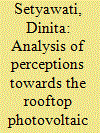

|
|
|
|
|
| Summary/Abstract |
In 2018, the Indonesian government issued the Rooftop Photovoltaic Solar Systems (RPVSS) policy that allows customers of the State Electricity Company (PLN) to generate their own electricity supply from solar photovoltaic (PV) systems and export surplus electricity to the national grid, valued at 65% of the full retail tariff. This policy is an effort to increase renewable energy levels in the national energy mix by 23% by 2025. Customer adoption of PV systems relies on the perceptions and perceived benefits of the technology, as well as general issues of confidence in the product. This paper explores the public's acceptance of the RPVSS policy from multiple perspectives. An online survey of PLN customers (n = 987) indicated consumer issues in adopting PV systems, such as high capital costs, long term return on investment and lack of information, as well as institutional issues such as the limited role of PLN and the absence of government financing mechanisms. Additional interviews with the government, private sector and energy experts identify the export rate for electricity injected into the grid as the main barrier to attracting prospective users. This paper's findings provide useful recommendations for policymakers to successfully implement the policy and increase solar energy deployment.
|
|
|
|
|
|
|
|
|
|
|
|
|
|
|
|
| 2 |
ID:
119996
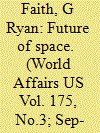

|
|
|
|
|
| Publication |
2012.
|
| Summary/Abstract |
Nearly one hundred countries, including the world's spacefaring nations, have formally agreed upon the principles set out in the 1967 "Treaty on Principles Governing the Activities of States in the Exploration and Use of Outer Space, Including the Moon and Other Celestial Bodies," more commonly known as the UN Outer Space Treaty. This document represents our global consensus on the fate and disposition of the rest of our solar system, of our galaxy's one hundred billion other stars (and their solar systems), and of the one hundred billion additional galaxies in the universe; it was all decided before the first moon landing.
|
|
|
|
|
|
|
|
|
|
|
|
|
|
|
|
| 3 |
ID:
042450
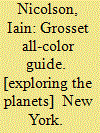

|
|
|
|
|
| Publication |
New York, Grosset & Dunlap, 1971.
|
| Description |
159p.Hbk
|
| Series |
The, Grosset all-color guide series
|
| Standard Number |
0448008688
|
|
|
|
|
|
|
|
|
|
|
|
Copies: C:1/I:0,R:0,Q:0
Circulation
| Accession# | Call# | Current Location | Status | Policy | Location |
| 008763 | 621.38238/NIC 008763 | Main | On Shelf | General | |
|
|
|
|
| 4 |
ID:
114246
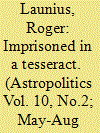

|
|
|
|
|
| Publication |
2012.
|
| Summary/Abstract |
This essay focuses on the decision by senior National Aeronautics and Space Administration (NASA) officials at the creation of the agency to focus its efforts on human spaceflight, Moon and Mars missions, and human settlement of the solar system. Its leaders made a conscious decision to downplay space applications projects, exclusive of technological research and development, and eschew operational activities. They did so in favor of concentrating on the human exploration and development of space. In so doing, NASA fell into the prestige trap that dominated this mission in the 1950s and early 1960s. At sum it was a tesseract, a four-dimensional object, which locked NASA into a quest for ever greater space spectaculars featuring human involvement. Power and prestige, therefore, has cast a long shadow on the space agency, forcing it into a series of programs that have been oversold and undervalued.
|
|
|
|
|
|
|
|
|
|
|
|
|
|
|
|
| 5 |
ID:
105729
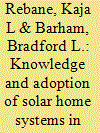

|
|
|
|
|
| Publication |
2011.
|
| Summary/Abstract |
Solar home systems (SHSs) are a promising electrification option for many households in the developing world. In most countries SHSs are at an early stage of dissemination, and thus face a hurdle common to many emerging alternative energy technologies: many people do not know enough about them to decide whether to adopt one or not. This study uses survey data collected in Nicaragua to investigate characteristics that predict the knowledge and adoption of SHSs among the rural population. First, a series of probit models is used to model the determinants of four measures of SHS knowledge. Next, a biprobit model with sample selection is employed to investigate the factors that predict SHS adoption, conditional on having sufficient knowledge to make an adoption decision. Comparison of the biprobit formulation to a standard probit model of adoption affirms its value. This study identifies multiple determinants of SHS knowledge and adoption, offers several practical recommendations to project planners, and provides an analytical framework for future work in this policy-relevant area.
|
|
|
|
|
|
|
|
|
|
|
|
|
|
|
|
| 6 |
ID:
116815
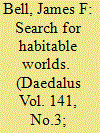

|
|
|
|
|
| Publication |
2012.
|
| Summary/Abstract |
The search for and detailed characterization of habitable environments on other worlds - places where liquid water, heat/energy sources, and biologically important organic molecules exist or could have once existed - is a major twenty-first-century goal for space exploration by NASA and other space agencies, motivated by intense public interest and highly ranked science objectives identified in recent National Academy decadal surveys. Through telescopic observations, terrestrial laboratory and field studies, and a "flyby, orbit, land, rove, and return" strategy for robotic exploration, particular emphasis will be placed on specific worlds already identified as potentially habitable: Mars, Jupiter's ocean moon Europa, and Saturn's icy and organic-bearing moons Titan and Enceladus. However, the potential abounds for surprising discoveries at many of our solar system's other planetary, satellite, and asteroidal destinations, as well as within newly discovered planetary systems around other stars.
|
|
|
|
|
|
|
|
|
|
|
|
|
|
|
|
| 7 |
ID:
108699
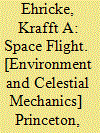

|
|
|
|
|
| Publication |
Princeton, New Jersey, D.Van Nostrand Company, Inc., 1960.
|
| Description |
xiii, 513p.Hbk
|
| Series |
Principles of Guided Missile Design
|
|
|
|
|
|
|
|
|
|
|
|
Copies: C:1/I:0,R:0,Q:0
Circulation
| Accession# | Call# | Current Location | Status | Policy | Location |
| 009797 | 629.41/EHR 009797 | Main | On Shelf | General | |
|
|
|
|
| 8 |
ID:
124933
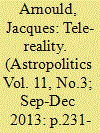

|
|
|
|
|
| Publication |
2013.
|
| Summary/Abstract |
With the introduction and development of space techniques, three types of remote reality, or tele-reality, have emerged: (1) the Earth, its environments, and its inhabitants have been brought closer to each of us; (2) the planets in the solar system are now "at hand's reach"-a robotic hand, that is; and (3) deep space is brought to our screens in three dimensions. But remote reality raises questions: What connection does it make between the perceptible and the intelligible; and what confusion does it maintain between what is real and what appears on the screen? New practices are challenging the way we handle the relationship between seeing, knowledge, and power, and questioning our ethical values. It is time and essential that we redefine the conditions and boundaries of our "tele-techniques."
|
|
|
|
|
|
|
|
|
|
|
|
|
|
|
|
| 9 |
ID:
132562
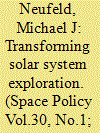

|
|
|
|
|
| Publication |
2014.
|
| Summary/Abstract |
The Discovery Program is a rarity in the history of NASA solar system exploration: a reform program that has survived and continued to be influential. This article examines its emergence between 1989 and 1993, largely as the result of the intervention of two people: Stamatios "Tom" Krimigis of the Johns Hopkins University Applied Physics Laboratory (APL), and Wesley Huntress of NASA, who was Division Director of Solar System Exploration 1990-92 and the Associate Administrator for Space Science 1992-98. Krimigis drew on his leadership experience in the space physics community and his knowledge of its Explorer program to propose that it was possible to create new missions to the inner solar system for a fraction of the existing costs. He continued to push that idea for the next two years, but it took the influence of Huntress at NASA Headquarters to push it on to the agenda. Huntress explicitly decided to use APL to force change on the Jet Propulsion Laboratory and the planetary science community. He succeeded in moving the JPL Mars Pathfinder and APL Near Earth Asteroid Rendezvous (NEAR) mission proposals forward as the opening missions for Discovery. But it took Krimigis's political skill and access to Sen. Barbara Mikulski in 1993 to get the NEAR into the NASA budget, thereby likely ensuring that Discovery would not become another one-mission program
|
|
|
|
|
|
|
|
|
|
|
|
|
|
|
|
|
|
|
|
|